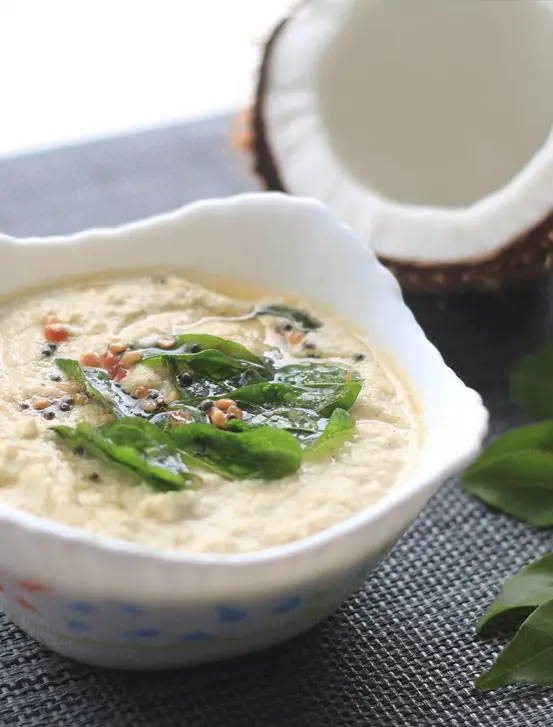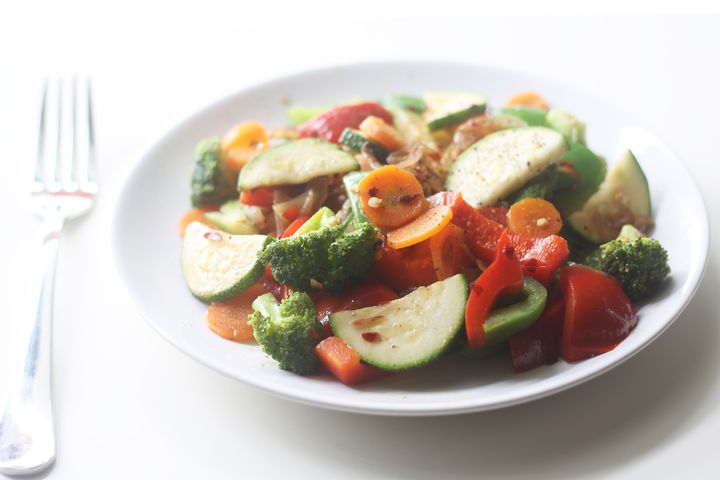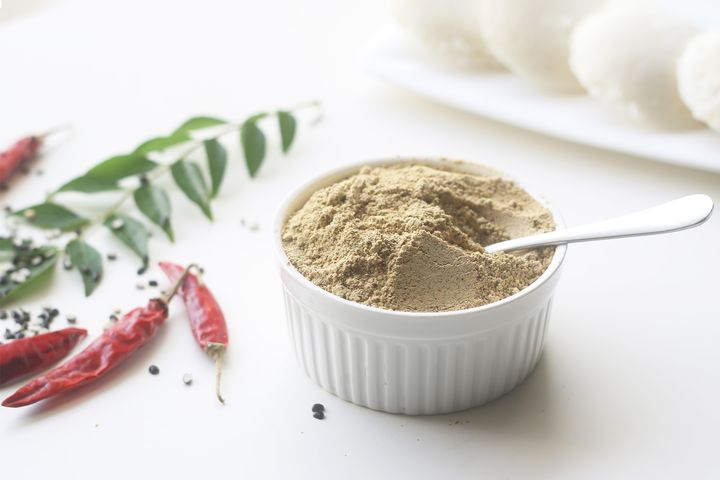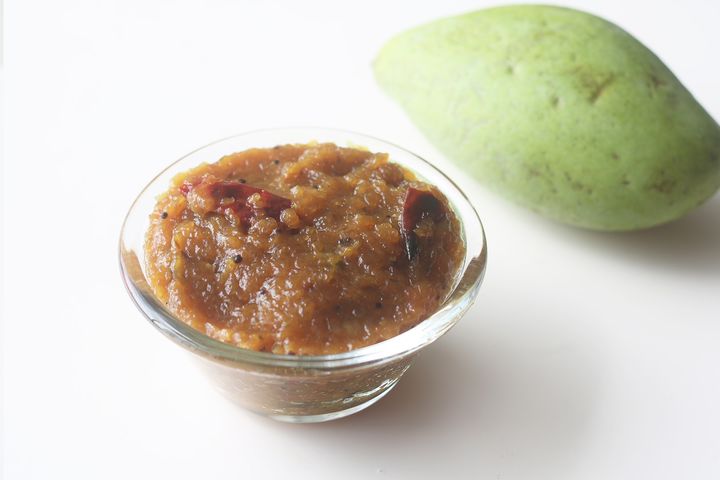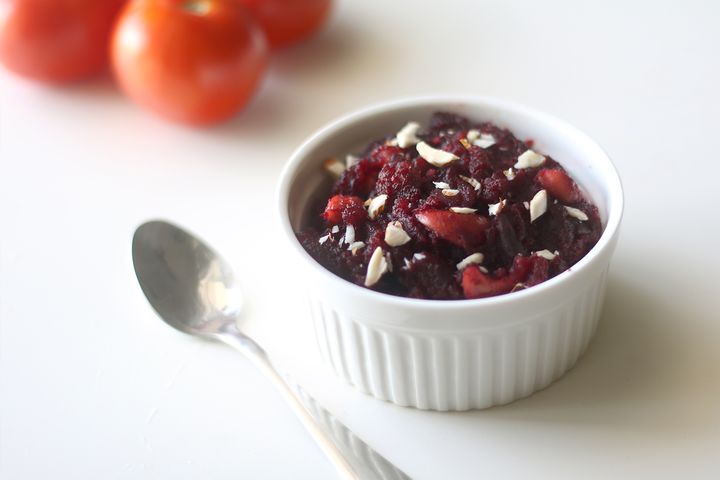South Indian Coconut Chutney
I learned the proportions of making this delicious chutney from my Mom during my early ages.
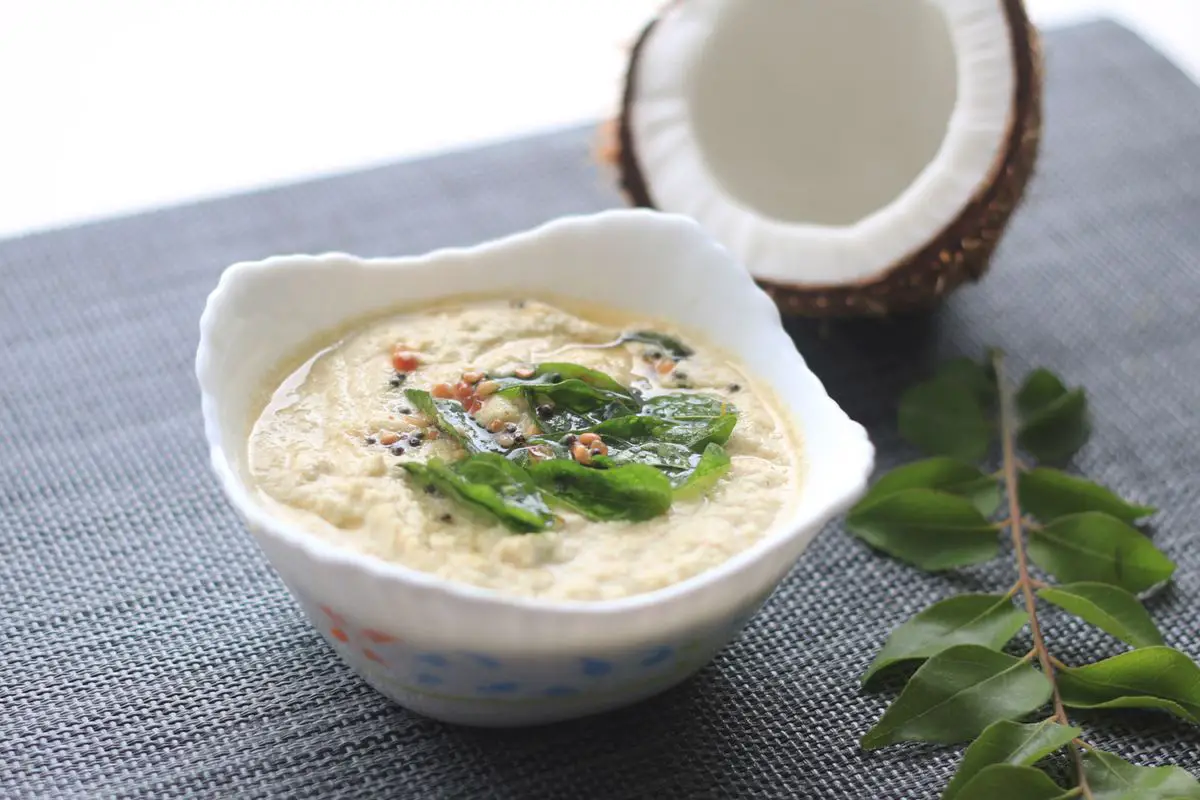
Coconut chutney is one of the favorite accompaniments for south Indian breakfast dishes like idli, dosa, vada and pakoras. I learned the proportions of making this delicious chutney from my Mom during my early ages. My Father-in-law admires the recipe of my chutney and hence asks me to make it whenever I visit his home. You too enjoy it at home with your family!
Welcome to our blog where we will be sharing a delicious recipe for South Indian coconut chutney. This classic condiment is a staple in South Indian cuisine and is the perfect accompaniment for dishes like idli, dosa, vadai, and pakoda. Our recipe includes a special tempering that adds an extra burst of flavor to the creamy coconut base. Let's dive in and learn how to make this unique and flavorful coconut chutney!
What Is South Indian Coconut Chutney?
- South Indian coconut chutney is a popular and versatile condiment that is often paired with traditional South Indian dishes like idli, dosa, vadai, and pakoda. This delicious chutney is made using fresh coconut slices, roasted channa dal, green chilies, and ginger, which are ground together to create a smooth and flavorful mixture. The addition of Indian spices like mustard, urad dal, and curry leaves gives the chutney a unique and aromatic seasoning, making it the perfect accompaniment to a variety of savory dishes.
Why You'll Love South Indian Coconut Chutney?
- Creamy Texture: The coconut chutney has a smooth and creamy texture, thanks to the fresh coconut slices and roasted channa dal. It adds a rich and satisfying element to any dish it's paired with.
- Healthy Fats: Coconut is packed with healthy fats that are great for brain health and overall well-being. Consuming coconut in the form of chutney provides a delicious way to incorporate these healthy fats into your diet.
- Digestive Aid: The ginger and green chillies in the chutney not only add a kick of flavor but also aid in digestion. These ingredients are known for their digestive properties, making the chutney not just tasty, but also beneficial for your stomach.
- Versatile Pairing: This coconut chutney isn't just limited to one dish. It pairs perfectly with a variety of South Indian dishes such as idli, dosa, vadai, or pakoda. Its versatility makes it a must-have in your culinary repertoire.
- Nutrient Boost: The combination of coconut, roasted channa dal, and curry leaves provide a healthy dose of nutrients like fiber, protein, and essential vitamins. This chutney can be a great way to add extra nutrients to your meal.
- Quick and Easy: With just a few simple steps, you can whip up this coconut chutney in no time. It's a quick and easy addition to any meal, perfect for busy weeknights or lazy weekends.
Ingredients for South Indian Coconut Chutney
- Fresh Coconut Slices: Fresh coconut slices are the key ingredient in South Indian coconut chutney, providing a creamy texture and a natural sweetness to balance the spicy and tangy flavors.
- Fried Gram/Roasted Channa Dal/Pottu Kadalai: This ingredient adds a nutty flavor and thickens the chutney, giving it a smooth and velvety texture.
- Green Chillies: Green chillies add a spicy kick to the chutney, balancing the richness of the coconut and the earthiness of the roasted channa dal.
- Ginger: The addition of ginger adds a hint of warmth and depth of flavor to the chutney, enhancing its overall taste.
- Salt: Salt is essential for balancing the flavors and bringing out the natural sweetness of the coconut, while also enhancing the spiciness of the green chillies.
- Sesame Oil, Mustard, Urad Dal, and Curry Leaves: These ingredients are used for tempering the coconut chutney, adding a burst of aromatic and savory flavors to the dish, complementing the creamy and spicy elements.
How To Make South Indian Coconut Chutney?
If you want to make delicious South Indian coconut chutney, follow these easy steps:
- Grinding the main ingredients: Start by placing 1/2 cup of fresh coconut slices in a small mixie jar or blender. Then add roasted channa dal, green chillies, and ginger. Grind until coarsely, and then add 1/4 cup of water and salt. Continue grinding until the mixture is smooth. If it looks too thick, add some water to get the right consistency.
- Preparing the tempering: While the coconut chutney is being prepared, heat a small pan with oil over medium heat. Once the oil is hot, add mustard and urad dal and fry until they start spluttering. Then, add the curry leaves and fry them until they become crisp. Switch off the heat and immediately pour the tempering onto the chutney. Mix well to combine the flavors.
- Serving the coconut chutney: Transfer the coconut chutney to a serving bowl and serve it with idli, dosa, vadai, or pakoda of your choice.
These steps are essential for creating a flavorful South Indian coconut chutney that pairs perfectly with various Indian dishes. Enjoy the delicious and authentic flavors of this classic chutney!

Serving Suggestions
- Perfect Pairings: South Indian coconut chutney is best served with dishes like idli, dosa, vadai, or pakoda. The creamy texture and subtle flavor of the chutney perfectly complement the savory and crispy textures of these popular South Indian dishes.
- Idli and Dosa: The soft and fluffy idlis and crispy dosas are an ideal match for the coconut chutney. The combination of the mild coconut flavor with the spongy idlis and crispy dosas creates a delightful flavor experience.
- Vadai: The crunchy texture of vadai pairs well with the creamy coconut chutney. The combination of the crispy exterior and the smooth chutney is a delightful balance of textures and flavors.
- Pakoda: The crispy and savory pakodas are a perfect match for the coconut chutney. The chutney adds a refreshing and creamy element to the spicy and crunchy pakodas, making it a delicious combination.
- Customization: Feel free to pair the coconut chutney with any other South Indian snack or breakfast dish of your choice to create a complete and satisfying meal.
- Variety: Experiment with different types of chutneys and sides to create a diverse and flavorful South Indian meal experience.
Tips for Making South Indian Coconut Chutney
How to select coconut:
When you buy a coconut, you should buy one that doesn’t have any cracks on the shell and feels heavy and full. Hold it up to your ear and shake it and it should sound like there’s water in it.
Types of coconuts:
There are two types of coconuts you can see in the market. The dark brown shelled coconuts are older than the white shelled coconuts. The brown is used for extracting coconut milk and the white is good for making chutney. On every coconut, there are ‘3 eyes’ or black spots. If these eyes are moldy or wet, avoid that coconut.
- Furthermore, a few of my suggestions for making perfect coconut chutney. Firstly, try to use white shelled coconut for this chutney as it gives a nice texture and taste.
- Secondly, don’t add too much of fried grams. If you don’t have fried grams, then you can add peanuts. If you add peanuts, then you can also add some tamarind. Adding tamarind to the chutney increases its shelf life a little more.
- Finally, consume the chutney within 5 to 6 hours. If you have to keep it for long hours, then keep it in the refrigerator. However, consume the chutney within a day.
- If you are using desiccated coconut or coconut powder, use warm water while grinding the chutney. But fresh coconut gives an excellent taste to your chutney.
Variations for South Indian Coconut Chutney
- Spicy Variation: Add a few extra green chilies to give the chutney an extra kick. This variation is perfect for those who love spicy food.
- Herb-infused Variation: Incorporate fresh cilantro, mint, or even curry leaves into the chutney for a refreshing and aromatic twist. The herbs will add depth of flavor to the chutney.
- Nutty Variation: For a richer and creamier texture, add a handful of roasted peanuts while grinding the chutney. This variation provides a nutty flavor and adds a satisfying crunch.
- Tangy Variation: Add a few pieces of tamarind for a tangy twist to the coconut chutney. This variation will add a refreshing and zesty flavor to the chutney.
- Sweet and Spicy Variation: Mix in a small amount of jaggery to the coconut chutney for a delightful combination of sweet and spicy flavors. This variation is perfect for those who enjoy a balance of sweet and heat.
- Nutrition Boost Variation: Incorporate spinach, kale, or any leafy greens to add an extra dose of nutrition to the chutney. This variation is not only delicious but also packed with added health benefits.
By trying out these different variations, you can make your coconut chutney unique and cater to your individual taste preferences. Experimenting with various ingredients will allow you to discover a new favorite flavor profile for this beloved South Indian condiment.
How to Store South Indian Coconut Chutney
- Refrigeration is key: After preparing the coconut chutney, it's important to store it in an airtight container and refrigerate it. This will help maintain its freshness and flavor for a longer period of time.
- Use fresh ingredients: To ensure the coconut chutney stays fresh, it's important to use fresh coconut slices and other key ingredients. Using stale or old ingredients can affect the overall quality of the chutney.
- Avoid moisture: When storing the coconut chutney, make sure to keep it away from moisture. Any moisture can cause the chutney to spoil quickly, so it's best to store it in a dry container.
- Proper temperature: Keep the coconut chutney at a consistent and cool temperature in the refrigerator. Fluctuating temperatures can cause ingredients to spoil, so it's best to store it in a cool environment.
- Avoid contamination: When serving the chutney, make sure to use clean utensils and avoid double-dipping to prevent any contamination. This will help maintain the freshness of the chutney for longer.
- Consume within a few days: Although the coconut chutney can be stored in the refrigerator, it's best to consume it within a few days to ensure its freshness and flavor. As with any homemade food, it's best to consume it while it's still at its best.
Frequently Asked Questions (FAQs)
Can I use desiccated coconut instead of fresh coconut slices?
- Yes, you can use desiccated coconut as a substitute for fresh coconut slices. However, the texture and flavor may vary slightly, so you may need to adjust the quantity to achieve the desired taste and consistency.
How can I make the chutney spicier?
- To make the chutney spicier, you can increase the quantity of green chillies while grinding the ingredients. You can also include a few pieces of dried red chillies during the tempering process for an extra kick of heat.
Can I make this chutney in advance and store it?
- Yes, you can prepare the coconut chutney in advance and store it in the refrigerator for up to 2-3 days. Make sure to use an airtight container to maintain the freshness and flavor of the chutney. Give it a good stir before serving.
What can I serve the coconut chutney with?
- Coconut chutney pairs well with various South Indian dishes such as idli, dosa, vada, and pakoda. It can also be served as a side condiment with meals or snacks.
How can I adjust the consistency of the chutney?
- If the chutney turns out too thick, simply add a little more water while grinding until you achieve a smooth and creamy consistency. On the other hand, if the chutney is too runny, you can add a small amount of roasted channa dal to thicken it.
Can I skip the tempering process?
- While the tempering enhances the flavor of the coconut chutney, you can choose to skip this step if you prefer a simpler version. However, the tempering adds a delicious aroma and a hint of crunch to the chutney, so it is recommended to include it if possible.
Recipe Card
South Indian Coconut Chutney
South Indian Coconut Chutney 2018-10-11 22:27:56

Serves 3 Print
Prep Time 00:07
Cook Time 00:03
Total Time 00:10
Ingredients
- 1/2 cup fresh coconut slices
- 0ne handful fried gram/roasted channa dal/ pottu kadalai
- 2 to 3 green chillies as per your taste
- 1 inch ginger
- salt as per taste
To temper
- 1/2 tbsp sesame oil
- 1 tsp mustard and urad dal mixed
- 1 spring of curry leaves
Instructions:
How to grind coconut chutney
- Place 1/2 cup of fresh coconut slices in a small mixie jar or blender.
- Then add roasted channa dal, green chillies and ginger and grind until coarsely.
- Then add 1/4 cup of water and salt and grind until smooth.
- If unable to grind or it looks thick, then add some water and grind until smooth.
- Transfer the coconut chutney to the serving bowl.
- Meanwhile, heat a small pan with oil over medium heat.
- When the oil heats, add mustard and urad dal and fry until spluttering.
- Then add curry leaves until they become crisp.
- Switch off the heat and immediately pour the tempering on the chutney and mix it well.
- Serve this coconut chutney with idli, dosa, vadai or pakoda of your choice.
By Santhi Therese The Indian Claypot
https://theindianclaypot.com/
